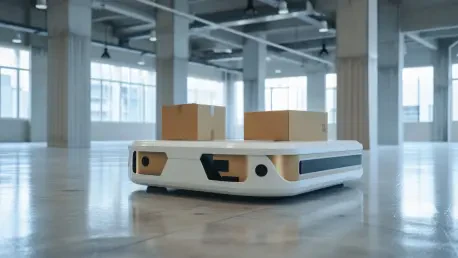I’m thrilled to sit down with Rohit Laila, a seasoned expert in logistics and supply chain management with decades of experience in the industry. Rohit has worked across various facets of delivery and fulfillment, and his passion for technology and innovation has made him a thought leader in shaping the future of e-commerce logistics. Today, we’ll dive into the intricate world of parcel delivery, focusing on the sophisticated systems and cutting-edge advancements that power operations in the UK, from fulfillment centers to doorstep delivery.
How does a typical Amazon order journey from a fulfillment center to a customer’s doorstep in the UK?
The process is a fascinating blend of precision and technology. It begins when a product arrives at a fulfillment center on lorries and is moved via conveyor belts to storage pods. Once a customer places an order, an associate, often aided by robotic drive units, picks the item. These robots move inventory efficiently around the center. The item then travels along conveyor belts for packing, with sophisticated systems scanning and tracking every step. After packing, it’s weighed for accuracy, labeled, and loaded onto a lorry for the next stage of its journey. It’s a highly orchestrated system designed for speed and reliability.
What role do advanced technologies like robotics and conveyor systems play in streamlining operations at fulfillment centers?
Robotics and conveyor systems are game-changers in fulfillment centers. The orange robotic drive units I mentioned earlier can move heavy inventory effortlessly, reducing physical strain on associates and speeding up the picking process. Conveyor belts ensure seamless movement of items from storage to packing stations, while computer systems monitor progress in real-time. This tech not only boosts efficiency—handling millions of products daily—but also minimizes errors, ensuring customers get exactly what they ordered, on time.
Can you explain how Amazon supports small businesses through its fulfillment services in the UK?
Absolutely. Through Fulfillment by Amazon, small business owners can store their inventory in Amazon’s centers, and the company takes care of packing, shipping, and even customer service. This levels the playing field for smaller vendors, like a home décor shop, allowing them to reach a national audience without investing in their own logistics infrastructure. For instance, a boutique selling wool blankets can focus on creating great products while Amazon handles the heavy lifting of delivery. It’s a win-win, as over half the items sold on Amazon.co.uk come from such entrepreneurs.
How extensive is Amazon’s network of fulfillment centers across the UK, and why is their location strategy important?
As of 2025, Amazon operates 31 fulfillment centers in the UK, strategically placed in locations like Manchester, Coventry, and Dunfermline. The scale is massive, designed to cover various regions efficiently. Their placement is critical because it reduces delivery times by positioning inventory closer to customers. It also helps balance the load across the network, ensuring no single center is overwhelmed, especially during peak seasons like the holidays. Location strategy is all about optimizing speed and cost.
What different transportation methods does Amazon use to get packages from fulfillment centers to customers?
Amazon employs a diverse transportation mix to ensure flexibility and speed. Their own lorries, which can carry over 2,000 boxes at a time, move packages from fulfillment centers to sortation centers or directly for delivery. They also partner with couriers like Hermes, DPD, and Royal Mail to handle last-mile delivery. Additionally, Amazon uses planes for longer distances or urgent shipments. The choice of method depends on factors like delivery speed, destination, and shipping option selected by the customer, ensuring the most efficient route is always taken.
Can you tell us more about Amazon’s push toward electric vehicles in their UK transportation network and its broader impact?
Amazon is making significant strides with sustainability by expanding its electric vehicle fleet in the UK. They’ve grown from nine to over 160 electric trucks, handling more than 300 million packages annually. This shift cuts down carbon emissions substantially, contributing to cleaner air and aligning with global environmental goals. On the efficiency front, electric vehicles often have lower operating costs over time, though the upfront investment is high. It’s a bold move that balances ecological responsibility with operational needs.
How do sortation centers fit into the delivery puzzle, and what happens there?
Sortation centers are a crucial link in the delivery chain. Once packages leave the fulfillment center, they arrive at these hubs to be organized based on destination and delivery speed—think standard versus same-day shipping. Here, they’re sorted and loaded onto the appropriate transportation mode, whether that’s an Amazon vehicle or a partner courier. This step ensures packages are routed efficiently, minimizing delays and getting orders to customers as quickly as possible. It’s like a logistical traffic controller.
What’s the latest on Amazon Prime Air and drone delivery in the UK, and how might it change the delivery landscape?
Amazon Prime Air is an exciting frontier. While it’s already delivered thousands of packages globally in under 60 minutes, in the UK, they’re working closely with the Civil Aviation Authority to launch commercial drone delivery. Their latest drone, the MK30, can fly farther, operate in varied weather like light rain, and carry items up to five pounds—think household essentials or tech supplies. Once rolled out, it could revolutionize last-mile delivery, especially for urgent or remote orders, by slashing delivery times and reducing road traffic.
What is your forecast for the future of delivery technology and logistics in the coming years?
I’m incredibly optimistic about the future. We’re on the cusp of transformative changes with drone delivery becoming more mainstream, alongside advancements in robotics within fulfillment centers. I expect to see even smarter AI systems optimizing routes and predicting demand with uncanny accuracy. Sustainability will remain a priority, with more companies following the electric vehicle trend and exploring alternative fuels. The focus will be on speed, efficiency, and reducing environmental impact—imagine same-hour delivery becoming the norm in urban areas. It’s an exciting time to be in logistics!









